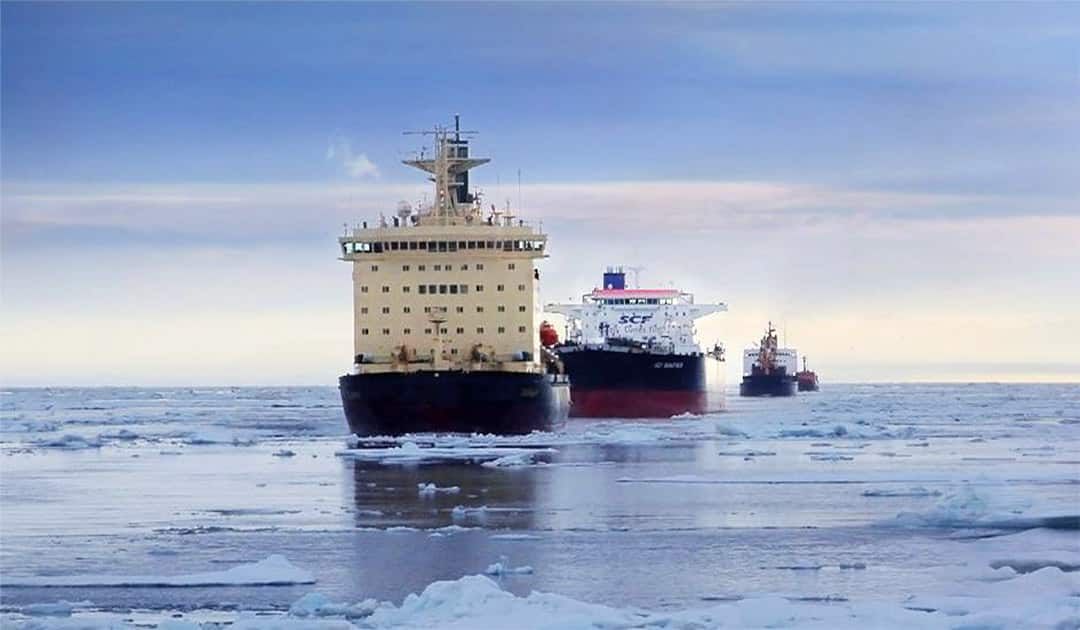
As soon as the traffic jam at the Suez Canal was over and the last ships were able to pass through the canal, the discussion about alternatives really started. Russia has used the blockade of the Suez Canal to offer its northern shipping route as a reliable alternative. This is just part of a broader push by Moscow to develop the Arctic and profit from climate change.

The Northeast Passage is “highly secure” and “competitive in terms of transportation costs, as well as reliability compared to alternative routes,” the ministry said. In addition, the traditional shipping route from Asia to Europe through the Suez Canal is 4,000 nautical miles longer.
“Of course, it is necessary to think about how to efficiently manage transport risks and develop alternative routes to the Suez Canal, especially through the Northern Sea Route,” Nikolay Korchunov, Russia’s government official for the Arctic, told Interfax news agency. Russia has invested heavily in the development of the route, which allows ships to shorten the journey to Asian ports by 15 days compared to using the Suez Canal.
The Eastern Arctic transit normally ends in November, but Russia hopes climate change will increase the route’s commercial usefulness. During the winter months, convoys led by new Russian nuclear icebreakers will be organized. For transit and icebreaking services, the government would impose additional tolls, he said. For comparison – a passage through the Suez Canal costs about 250’000 USD.
Last year, a total of 33 million tons of cargo were shipped on the Northeast Passage, while more than 3 million tons of cargo per day pass through the Suez Canal. By 2024, 80 million tonnes are already expected to be shipped along the Northern Sea Route.
However, given the increasing volume of trade, it is inevitable that additional short routes for cargo delivery will be created, a spokesman for the Russian Energy Ministry said.

How safe and profitable is the Northeast Passage
In August 2017, the first ship without an icebreaker sailed along the Northern Sea Route. This was followed by a number of attempts by various shipping companies. Due to the limited usability during some months in summer, the large container shippers all announced that they would refrain from using the Northeast Passage. Just last week, the shipping company MSC announced that it would definitely not sail the Northern Sea Route due to environmental reasons. What remained were the LNG carriers, which carried their cargo from Sabetta to the Far East, as well as some oil tankers and coal carriers from Russian stocks.
Only a few months ago, the LNG freighter “Christophe de Margerie” made its first winter passage in a ‘test run’. On the way back to Sabetta, the nuclear icebreaker “50 Let Pobedy” was waiting for the LNG carrier in the Bering Strait. Together, the two ships made the Northeast Passage from east to west. To demonstrate the feasibility, this message was widely shared.
The LNG carrier “Nikolay Yevgenov”, which departed Sabetta just one day after the “Christophe de Margerie”, bound for China, slowed down its voyage on January 16, presumably because the Azimod suffered damage. After that, things got pretty quiet around the ship until it resurfaced. But this was not in Russia, but in the dry dock of a shipyard in Brest, France. It is the second LNG carrier that had to go to Brest for repairs in December 2019.

Since the major shipping companies had already announced for some time that they would avoid the North-East Passage, another plan had to be devised. For example, the government in Moscow intends to build container terminals on both sides of the Northern Sea Route. The advantage of this is that cargo can be delivered or collected on both sides of the Northeast Passage without having to travel through the passage itself, which is icy in winter. Normal container ships are sufficient for delivery and collection, while the Northeast Passage requires icebreaking vessels. These would be frequented by Russian cargo ships.
This should massively shorten the transit time of containers from the Far East to Europe and would also be an alternative to the Suez Canal. With freight volumes forecast to grow significantly in the coming years, congestion at the Suez is likely to increase.
Heiner Kubny, PolarJournal
More on the subject:





